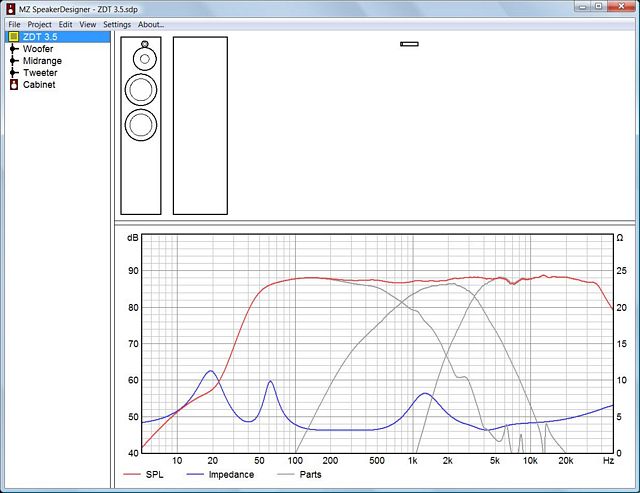MZ SpeakerDesigner simulates complete passive loudspeakers and predicts
all major data used in speaker design. As this is done in the abstract,
no measurements are required to get a simulation. Actually I do not have
a single speaker shown above...
The only exception is the driver database. A driver defined only by its
Thiele-Small parameters will not give accurate results. A reference
measurement is required to adjust the impedance and spl simulation of
the driver. Fortunately and unlike other programs, MZ SpeakerDesigner
does not need phase data from measurements. Therefore you can use any
impedance or spl graph you find in datasheets, magazins or the internet
for that purpose, provided the measurement conditions are known and the
data is not too much faked, as few manufacturers still do. Faster and
easier is to import an electronic data file. Great compliment to Wavecor
for providing this service!
The system database of the first version of MZ SpeakerDesigner will be
small but reliable. I only add drivers to the system database, if I have
at least three independent sources, which are more or less in accordance.
The Thiele-Small parameters may differ slightly from manufacturers data.
The accuracy of the simulation stands and falls with the driver data
used. If you compare independent measurements of the same driver, you
will often find significant differences. For that reason you can enter
different data sets of the same driver in MZ SpeakerDesigner and switch
between them.
The biggest problem in simulation accuracy are surround resonances and
the cone break-up at higher frequencies. They interact with the baffle
edges and yield sometimes results, that are really hard to predict. I'm
still working on that...
The knee in the SPL simulation at 20-30 Hz is caused by rear side vents,
as their distance to the microphone is greater than the distance of the
driver on the front. This effect disappears with increasing microphone
distance.
The maximum SPL of a driver is limited in the simulation by its linear
excursion and continuous power handling capability. According to
that, MZ SpeakerDesigner displays the save operating area (SOA) of a
loudspeaker. Expect the real (short time or distorted) maximum SPL to
be about 3 dB higher.
|
